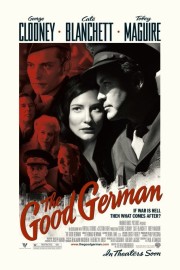The Good German
Once you become accustomed to Steven Soderbergh’s style in this thriller, the story sucks you in, and keeps you intrigued. The only film I can immediately compare this to is Gus Van Sant’s shot-for-shot remake of “Psycho,” another seeming film school experiment meant to interest more as an experiment than as a mainstream entertainment. Just another way Soderbergh- an Oscar-winner for “Traffic”- continues to go boldly where most mainstream filmmakers are afraid to go. He could have turned “German”- adapted from Joseph Kanon’s contemporary novel with a keen intelligence and verbal style by Paul Attanasio- into a straight period film set in Berlin in the days after World War II, with an army war correspondent (George Clooney’s Jake is a romantic hero in the tradition of Bogart’s Rick in “Casablanca,” whom the Oscar-winner plays with a timeless charisma) sent to cover a peace conference before he gets caught up in a murder investigation when his driver (Tobey Maguire drops the boy-next-door image to reveal the dark soul of his baby-faced character Tully) winds up dead, but not before Jake finds him out with his old flame Lena (Cate Blanchett, making up for her near-cameo in “Babel”- albeit a dramatically-strong cameo- with seductive and entrancing work here), who’s looking to get herself out of Germany.
A period film would have been dull, and Soderbergh- arguably the greatest filmmaker to emerge from Sundance- doesn’t know how to make a dull film or an obvious move (even his worst films- “Ocean’s Twelve,” “The Underneath”- deserve one viewing). And he puts his creative balls on the table for “German.” His goal with his second film of 2006- after his low-budget, distribution experiment “Bubble” (an early ’06 gem)- is to show that yes, you can make them like they used to…literally. Usually, all that means is a smart script, deft casting, and smarter filmmaking; for Soderbergh, that means shooting the film with boom mikes (no wireless), in black-and-white “box” formatting (Soderbergh’s cinematography pseudonym Peter Andrews is up to the challenge, and doesn’t disappoint; neither does his editor alter ego Mary Ann Bernard for keeping the story moving), shooting on backlots, utilizing stock footage, and making the soundtrack less-than-digital (which sucks for Thomas Newman’s thrillingly romantic and evocative score, a tribute to those great, bombastic scores of the time by Max Steiner and Franz Waxman, among others; but that’s the only downside). It’s a bold move that wouldn’t work with any cast (Blachett, Clooney, and Maguire have always felt timeless as stars and actors), with any script (2-time Oscar nominee Attanasio finds that heightened verbal tone from the ’40s even while coloring the dialogue some), with any director (more than any other modern filmmaker, the versatile and visionary Soderbergh could have thrived in the old studio system). Whether it’s a form-busting indie (his 1989 debut “sex, lies, and videotape”), a simple coming-of-age story (1993’s “King of the Hill,” still one of his best and shamefully not on DVD), a juicy piece of studio pulp (1998’s “Out of Sight,” which has aged superbly, and 2001’s “Ocean’s Eleven”), a multi-faceted Oscar winner (2000’s “Traffic”), or a fresh homage to the classic studio system, which “The Good German” works best as, Soderbergh- in a scant 17 years- has engaged fans of the art of cinema in one of the most distinguished and adventurous careers in the medium’s history. Budding filmmakers- this is a film artist to learn from.










